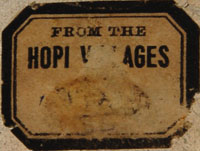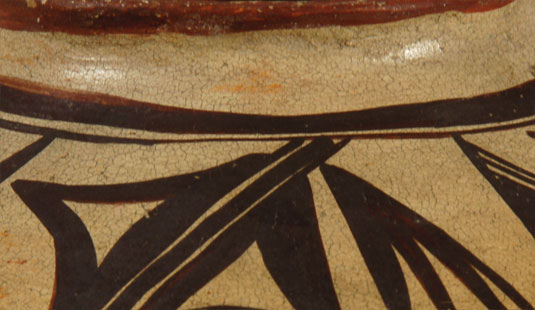Nampeyo Jar with Polacca Slip and Red Rim, ca 1885 [SOLD]
+ Add to my watchlist Forward to Friend
- Category: Historic
- Origin: Hopi Pueblo, Hopituh Shi-nu-mu
- Medium: clay, pigment
- Size: 4-1/2” height x 8” diameter
- Item # C3776H SOLD
There was a time in the mid-1800s that the government and the populace expressed disdain for Native Americans. It was openly expressed that they should be assimilated into the prevailing white culture. Children were taken from their parents and sent to strange places with strange schools and Christian teachers. Their hair was cut, their traditional clothing taken away, and their native language forbidden. The Bureau of American Ethnology was sent to the West to acquire all the ethnographic items from the pueblos before their assimilation occurred because there would then be no more traditional native items being made.
Most of this attitude began changing in 1880 when the transcontinental train passed through New Mexico. The Fred Harvey Company enthusiastically promoted the native culture and the artists of Taos and Santa Fe. It must be given credit for changing America’s attitude toward its native cultures, particularly in the Southwest.
Nampeyo of Hano was in the right location at the right time. Excavations at the prehistoric Sikyatki ruins, the publicity of the Hopi Snake Dance by the Fred Harvey Company, the enthusiasm of local trader Thomas Keam, and the inherent artistic talent of Nampeyo combined to make her the preeminent potter at Hopi. This was not easy on her traditional Hopi life, as it was not the custom for someone to stand out as better than others. Nampeyo was chided by her neighbors for doing so.
 In her earlier phase of the 1870s and 1880s, she used a thick slip that crazed during firing, now referred to as Polacca slip. Designs were black and the underbody and rim were sometimes red. This jar shows crazing of the yellow surface, has black simple designs, and a red rim. There is a paper label on the underbody that reads From The HOPI VILLAGES, a label often seen on early Nampeyo pottery. This is an excellent example of her pre-Sikyatki period when she was using Polacca slip. This jar possibility dates to 1885.
In her earlier phase of the 1870s and 1880s, she used a thick slip that crazed during firing, now referred to as Polacca slip. Designs were black and the underbody and rim were sometimes red. This jar shows crazing of the yellow surface, has black simple designs, and a red rim. There is a paper label on the underbody that reads From The HOPI VILLAGES, a label often seen on early Nampeyo pottery. This is an excellent example of her pre-Sikyatki period when she was using Polacca slip. This jar possibility dates to 1885.
Condition: extraordinary condition for a jar of this age
Recommended Reading: Canvas of Clay – Seven Centuries of Hopi Ceramic Art by Wade and Cooke
Provenance: from a private collection

- Category: Historic
- Origin: Hopi Pueblo, Hopituh Shi-nu-mu
- Medium: clay, pigment
- Size: 4-1/2” height x 8” diameter
- Item # C3776H SOLD



